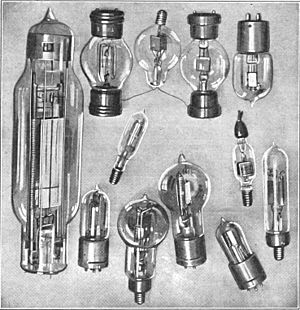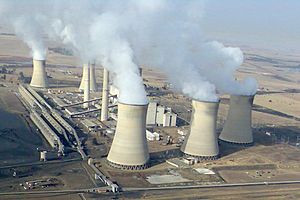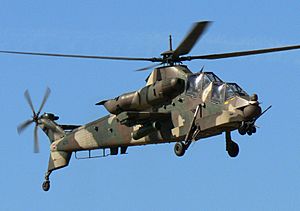Hendrik van der Bijl facts for kids
Quick facts for kids
Hendrik Johannes van der Bijl
|
|
|---|---|
| Born | 23 November 1887 |
| Died | 2 December 1948 (aged 61) |
| Citizenship | South African |
| Alma mater | Leipzig University |
| Spouse(s) | Florence Wagner (m. 1915) Ethel Buxton (m. 1942) |
| Awards | Fellow of the Royal Society |
| Scientific career | |
| Fields | Electrical engineering |
| Institutions | Western Electric Eskom ISCOR University of Pretoria |
| Thesis | The behaviour of ionized liquid dielectrics during the passage of electric currents (1912) |
Hendrik Johannes van der Bijl (FRS) was a famous South African electrical engineer. He was born on November 23, 1887, and passed away on December 2, 1948. Many people consider him one of the most important South Africans. He helped build the country's industries.
He was the main person behind creating two very important companies. One was Eskom, which provides electricity across South Africa. The other was ISCOR, a big steel company.
Contents
Early Life and Education
Hendrik van der Bijl was born in Pretoria, South Africa. He was one of eight children. His father, Pieter van der Bijl, was a successful merchant. He knew important politicians like Jan Smuts.
When Hendrik was young, there was a lot of tension in the country. He even helped his father stack rifles for the local forces. When he was 13, the Second Boer War started. He saw British soldiers take over Pretoria. His school even became a camp, so he had to leave.
In 1902, his family moved to Gordon's Bay. Hendrik went to school there and later to Boy's High School. He finished high school in 1904. Then he went to Victoria College, which is now Stellenbosch University. He did very well in Physics, Mathematics, and Chemistry. He even won special prizes for his studies.
Studying in Germany and America
In 1908, Van der Bijl went to Germany to study physics. He studied at Leipzig University. He earned his PhD in March 1912. After that, he worked as a physics assistant in Dresden. There, he met Robert Andrews Millikan, a famous scientist. Millikan helped him get a job at Western Electric in New York. This company later became part of the Bell Telephone Company.
For seven years, Hendrik worked in New York. He studied the first three-electrode thermionic valve, also called the "Audion." This device was invented by Lee de Forest. Hendrik's research helped put the first Audion to use. It was used as a repeater on the telephone line between New York and San Francisco. A repeater makes a signal stronger so it can travel long distances.
In 1915, he helped create a special circuit. This circuit was used with the Audion for wireless communication. It allowed people to talk wirelessly between New York and Wilmington, Delaware, and even between Paris, France and Honolulu, Hawaii.
In 1920, Van der Bijl wrote a book called The Thermionic Vacuum Tube-Physics and Electronics. This book became a very important textbook for over 20 years.
Returning to South Africa
In 1919, Van der Bijl wrote a paper about how scientific research could help industries grow in South Africa. Because of this paper, Jan Smuts, a leader in South Africa, asked him to come back home. Smuts offered him a job as a Scientific and Industrial Advisor. Hendrik accepted and returned to South Africa in 1920.
Building Industries in South Africa
Van der Bijl believed that companies controlled by the government could be very successful. He thought they should get money from the state but be run like regular businesses.
Electricity for the Nation
His first big project was to create the Electricity Supply Commission (ESCOM). This company is now known as Eskom. He became its first chairman in 1922 and stayed in charge until he passed away. ESCOM's job was to provide electricity all over South Africa. This was especially important for mines, factories, and to power the railway system.
Eskom was a huge success! South Africa got enough affordable power for its fast-growing industries. The company even paid back the government loan in just 10 years.
Making Steel for the Country
His next major project was to set up the Iron and Steel Corporation of South Africa (ISCOR). He became its chairman in 1925. At that time, South Africa didn't have many people who knew how to make steel. Van der Bijl solved this problem. He brought together experts from different countries. They helped train South Africans who had engineering degrees. These South Africans learned how to make steel in other countries.
ISCOR also became a big success. From 1934, it provided affordable steel for South Africa.
Supporting the War Effort
During the Second World War, Van der Bijl played another vital role. He was put in charge of war supplies. He later became a director in the company that would become the Armaments Corporation of South Africa (ARMSCOR). South Africa became an important supplier for the Allied forces. They provided things like spare parts, guns, ammunition, armored cars, and even food and clothing.
He also helped start many other important organizations in South Africa, including:
- The African Metals Corporation (AMCOR) in 1937.
- The Industrial Development Corporation of South Africa in 1940. This group helps new industrial businesses get started.
- Safmarine in 1946. This shipping company helped create sea routes between the US and South Africa.
Recognition and Awards
Hendrik van der Bijl received many honors for his amazing work:
- In 1927, he became the President of the South African Institute of Electrical Engineers.
- From 1934 to 1948, he was the Chancellor of the University of Pretoria.
- In 1944, he became a Fellow of the Royal Society, a very high honor for scientists.
- He was also an honorary member of the Koninklijk Instituut van Ingenieurs.
- The city of Vanderbijlpark is named after him. This is where ISCOR's main steel works are located.
- A primary school in Emfuleni is also named after him.
- The Hendrik Van Der Bijl award is given every year. It recognizes excellent science projects at the Eskom Expo for Young Scientists.
- The University of Pretoria holds a special lecture series in his memory.
- He received honorary PhD degrees from the University of Stellenbosch and the University of Cape Town.
Personal Life
In 1915, Van der Bijl married Florence Wagner, an American woman he met in Germany. They did not have any children. Later, in 1942, he married Ethel Buxton. They had one son and two daughters.
Hendrik van der Bijl passed away from cancer on December 2, 1948.
See also
- Eskom
- Armscor (South Africa)




